



There are a myriad of machines in the shop which cut, sand, drill, face, turn, bend, grind, and much more. But the underlying concepts are the same: the criteria for optimal performance is the rate of removal of material from the work piece.
It may seem that you can push a machine harder to rush a job: run at a higher speed or take a deeper cut. But this causes problems such as an uneven finish, tool wear and breakage, and danger to the operator.
You have to look at machining as a total process, where the choice of one parameter will probably affect other parameters in the system. The sections below describe how the choice of material, blade parameters, and machine settings affect the amount of material removed.
This 'textbook knowledge' is important to understand, but don't neglect human senses and experience. You can see the work piece is off center, or hear the whine of a tool rubbing against the piece and not cutting it. The operator is just as important as the machines themselves.
Microstructure
The most important factor in determining the strength of a metal is its microstructure, followed by any cold work or other hardening like anodizing. The harder the metal, the slower you must cut (to maintain the same temperature).
In machining processes, you are not only bringing two surfaces together (the tool and the part), but also breaking molecular bonds. Both of these create incredible levels of heat. Never touch a freshly machined surface. It doesn't need to glow red to be hot.
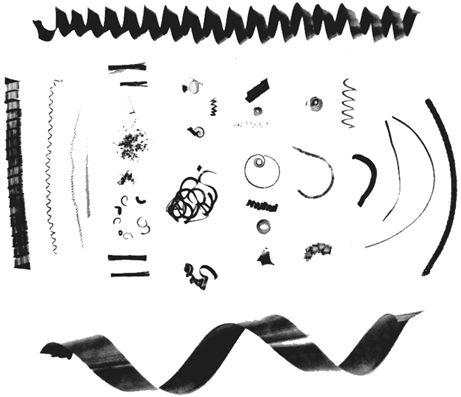
|
Chips
Chips are a byproduct of the machining process. Usually they are recycled or thrown away after you finish the job. However, they also give valuable clues about the efficiency of the machining process, and they can be used in troubleshooting.
One easy way to judge the quality of the machining process is to look at the 'chips,' or material resulting from the machining process.
- Functional requirements
- smooth flow away from work area
- convenient size/shape for disposal
- drop away from the workpiece or tool without getting tangeled
- Physical characterics
- deep serrations
- rigidity between serrations
- not flexible
- steered toward obstacle to break it
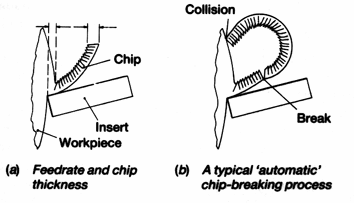 |
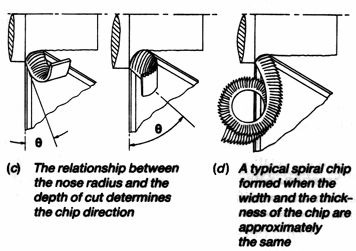 |
The type of chip depends on the machining process and the material. Note, however, that there is no correlation between the strength of the material and its corresponding chips.
You want to avoid long chips, which are usually indicative of cutting too much material or setting the tool at the wrong angle. In the first case, simply reduce the depth or feed rate, and make an extra pass to obtain the desired effect.
| Dust | Small chips | Medium curls | Tangled spirals; | |
| Machine | Grinder, sander, band saw | Lathe, milling machine | Lathe, drill press | Lathe, drill press |
| Material | (most) | Brass, cast iron | Steel, aluminum | Plastic |
| Potential problem | Lung irritant | Sharp edges | Sharp edges | Interferes with work, gets caught in tool |
| Clean-up | Wear mask, hook up vacuum to machine, use oil to damp down dust | Brush and dustpan | Brush and dustpan | Brush and dustpan, use hands |
Producing chips (i.e., cutting the material) is a very power-consuming process. About 80 percent of the energy used in cutting is expended as heat. Chips, by nature, have a very high surface area-to-volume ratio. This means that they cool off quickly. But more importantly, you want to clear the chips away so they won't interfere with the cutting process. For example, when drilling a deep hole, chips can stagnate and rub against the walls of the hole at high speeds, creating even more heat.
The most important thing to understand about cutting edges of any shape is that they are designed for a particular purpose. While `any' blade can cut most surfaces, you may cause premature damage by doing so. This section concentrates on how to select the right tool.
There are two broad categories for removing material from a piece of stock: cutting and grinding. Cutting processes apply a sharp edge in one direction, whether as a tool by itself or in line with other teeth to form a blade. Grinding processes involve a surface with tiny cutting edges in every direction, such as a belt sander or a grinding stone.
Blade material
Obviously, material removal tools must be harder than the material they cut. Most blades -- band saw, flutes of a drill bit -- are made of tool steel. Criteria for the design of blades include: hot-hardness, resistance to thermal shock, lack of affinity between tool and workpiece, resistance to oxidation, and toughness.
Many grinding-type tools use a variation of sandpaper and abrasives. For example, the belt sander uses a loop of sandpaper, while a buffing wheel uses small abrasive particles embedded in wax. The hardest grinding tool is the grinding stone, which is used to remove material even from pieces of tool steel.
Direction of cut
You will notice that most saws have asymmetric teeth that lean in one direction; this means that they can only be used to cut in one direction. For example, a hand saw cuts only on the down stroke. By putting weight on the saw during the up stroke, you are wearing down the back side of the blade teeth and also wasting energy. By analogy, the band saw only cuts in the down direction, and a drill bit only cuts in the "forward" direction. That isn't to say that material is not removed if you cut in the wrong direction; it is simply not the optimal mode of operation for tool life, quality of the cut, or energy spent.
On machines which remove material using multi-faceted cutting surfaces, the direction is based more on safety and not so much on the effectiveness of the machine. That is, if the machine was to pull the work piece out of your hands, would it fly up or down? In the direction which it flew, would one of your body parts be in the path of this fast, sharp object?
The following figures illustrate the possible situations on a round sander, with the position of a person's hands (red sphere), the work piece (blue rectangle), the direction of the machine (white arrows), and the resulting situation if the person lost control of the work piece (aqua arrow).
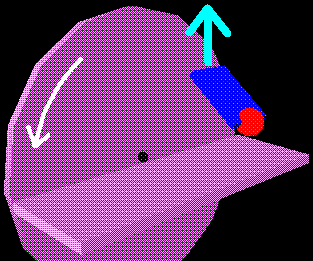 |
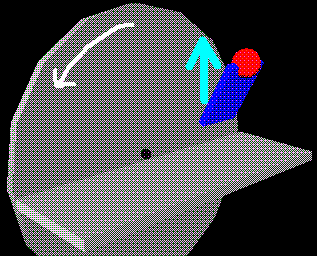 |
| WRONG! The work piece would fly upward and could hit somebody across the room. | WRONG! Same danger of flying upward. |
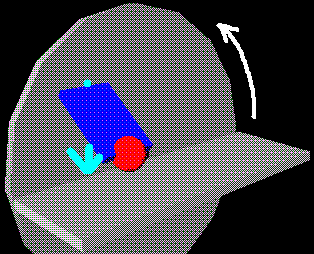 |
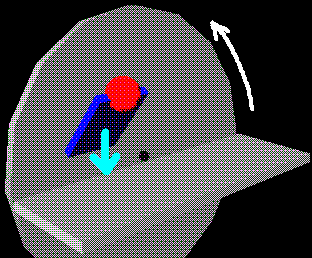 |
| WRONG! As the work piece is sucked downward, it is buffered by the force of the operator's hand slamming onto the bench. A thin piece of metal could chop off fingers or trap them against the spinning sanding surface. | BEST CHOICE The work piece would get sucked into the machine, but there is a minimal chance of somebody getting hurt. |
Force on a blade
The force of impact on a cutting blade depends on the rate of material removal. i.e., how fast the blade is running, how fast material is being fed into it, and how much material is being removed by each tooth each time around.
The figure below shows the terminology used to describe parts of a lathe tool and a drill bit. Although they differ in shape, many of the same parts have the same functionality.
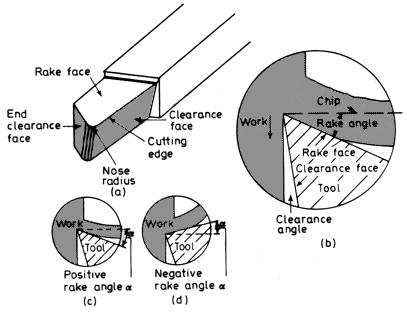
|
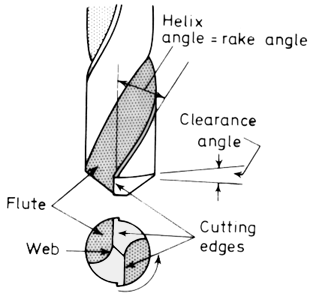
|
| A lathe tool | A drill bit |
All of these factors affect the settings of the others. To drill a large-diameter hole, each flute of the drill bit is in contact with more of the material; thus, you should use a lower spindle speed. Geometry is also important in these parameters. For example, a good rule of thumb is to have three teeth of the bandsaw blade in contact with the material. When the distance between blade teeth is comparable to the width of the work piece, each tooth would ``slam'' into the work piece when after the previous one lost contact.
The force on the ``blade'' has a similar analogy in grinding applications. Each grain of sand on the sander or nook in the grinding stone takes off material. If either is run too quickly, the material will overheat and melt on the surface of the sander or grinder. There is no good way to remove the excess except to change the sand paper or break away bits of stone with a special tool.
There are several ways to tell if you are pushing the limits of your tools: smell of smoke, high-pitched whining noise, excessive vibration, rapid overheating, and examination of chip shapes.
The rake angle -- angle of the tool with respect to the cutting direction -- is an important design aspect in machine shop tools, but we will assume that the student is not specifically designating this angle. The important thing to know is that the rake angle helps determine the size and shape of the chip, and that specialized tools have certain requirements.
Rigidity of the machine
The main advantages of a machine tool over a hand-held power tool are the rigidity of the machine and the precision of the operation. Machines use their large weight and have thick iron supports to minimize flexibility.
Guide height
Some shop machines have a guide that provide a path for the moving blade. There is less room for the blade to wander, and the cut is more precise. You should set this guide as close to the work piece as possible.
Clamp location
A clamp holds the work piece in place and provides more rigidity in the machining process. Clamps may be fully removable (like a C-clamp) or part of the machine. You should set the clamp as close to the cutting position as geometry permits.
Cutting speed
The cutting speed is the most important factor to extending tool life. This refers to the speed of the machine, like how fast a drill bit is spinning, or how fast the belt sander is passing by.
Feed rate
The feed rate refers to the speed at which the material is fed into the tool. This is equivalent to how fast the operator is pushing a drill bit into a piece of stock, or how hard a piece is held up against a grinder.
Depth of cut
The depth of cut refers to the width of material in contact with the tool. In some machines, like the drilling machine, this is related to the speed and feed rates. In other machines, it is also dependent on the position of the tool relative to the work piece.
On the grinding-type tools, the width depends on how much of the surface is being ground. On the band saw, you can choose a blade with a different width depending on the application.
Cutting fluid
Cutting fluid is used to both cool and lubricate the cutting surfaces. It is extremely important in situations (like creating threads with a tap) where there is a large surface area in constant contact and little airflow to help remove the heat.
Cutting fluid can help to extend tool life, reduce warping of the work piece, and improve the surface finish. In addition, it can 'damp down' the dust particles from certain machining operations.
There are three common ways to apply cutting fluid:
|
|
Cutting fluids are designed based on the following criteria:
|
|
|
Note that some cutting fluids cannot be used for all machining processes.
Quenching the work piece
Some processes, such as grinding, heat up the work piece very quickly, making it difficult to handle. A bucket of water or oil (depending on the material) is used to quickly cool off the piece. However, this may introduce residual stresses and should not be used for precision parts.